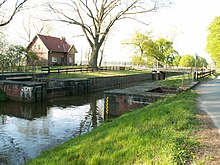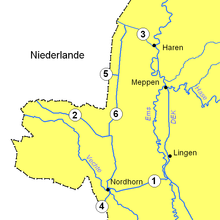Left-Semsian sewer network
The Left Ems Canal Network (also known as Left Ems Canal, abbreviated as: LEK) is a network of seven canals in western Lower Saxony (counties Grafschaft Bentheim and Emsland ) on the border with the Netherlands that were built on the left or west of the Ems .
history
The sewer network was built between 1870 and 1904 and has a total length of 111 kilometers. The moors and swamps in the area between the Ems and the German-Dutch border were to be drained through systematic canal construction. In addition, the industry required increasing transport capacities. Until 1874, prisoners of war from the Franco-German War were used to build it. The canals had a total of 20 locks and 90 bridges and were suitable for ships with a load capacity of up to 200 tons. However, the importance of these waterways as a means of transport decreased steadily. In 1899, the Dortmund-Ems Canal was opened and the Emsland industry was able to cover its heating material needs with coal from the Ruhr area . Shipping on the canals was discontinued between 1960 and 1965; today they are used for drainage. Only the Haren-Rütenbrock Canal remained navigable and connects the Ems with the Dutch canals. The Ems-Vechte Canal was also reopened for shipping on November 14, 2005 through the initiative of the Nordhorn association Graf-SHIP . The canals were operated by the Linksemsischen Kanalgenossenschaft and, since 2006, by the Meppen branch of the Lower Saxony State Agency for Water Management, Coastal Protection and Nature Conservation .
channels
The left-Emsian sewer network includes:
- Ems-Vechte Canal (EVK)
- Georgsdorf-Piccardie-Coevorden Canal (CPK)
- Haren-Rütenbrock Canal (HRK)
- Nordhorn-Almelo Canal (NAK)
- Schöninghsdorf-Hoogeveen Canal (SHK)
- South-North Canal (SNK)
- Nordhorn connecting canal
Drainage

Since canals are constantly losing water through seepage, evaporation and the sluice processes, the LEK has a system of inflows and outflows that are supposed to ensure a constant water level. Here is an (incomplete) description:
The dewatering begins from the Ems in Lingen through the Ems-Vechte Canal. This in turn fills the south-north canal, which has a slight current to the north and in turn supplies the Coevorden-Piccardie Canal and the Haren-Rütenbrock Canal with water. The HRK drains into the Ems near Haren . The EVK has an overflow at its end over the Nordhorn coupling lock . The CPK has an overflow canal towards Vechte near Emlichheim . At lock 2, the SNK is under a ditch , an overflow can also be seen here.
Graf-SHIP e. V.
On July 15, 2003, Graf-SHIP eV ("Grafschafter Schiffswege und Häfen - Repair Project eV") was founded with headquarters in Nordhorn .
The aim of the association is the restoration, repair and maintenance of listed ports and locks and the reopening of the Left Ems canal network. With the reopening of the Ems-Vechte Canal for pleasure craft up to 12 m in length and the restoration of the Nordhorn Klukkert Harbor , the association's first goals have already been achieved.
The association works together with the Maritime Museum , where studies on canal history as well as exhibitions and lecture evenings on the subject of inland navigation are offered.
photos
The border lock Frensdorfer Haar of the NAK
See also
literature
- Emsländischer Heimatbund (Hrsg.): 100 years Dortmund-Ems Canal: The story of a waterway in Emsland . Sögel, 1999, ISBN 3-88077-136-7








